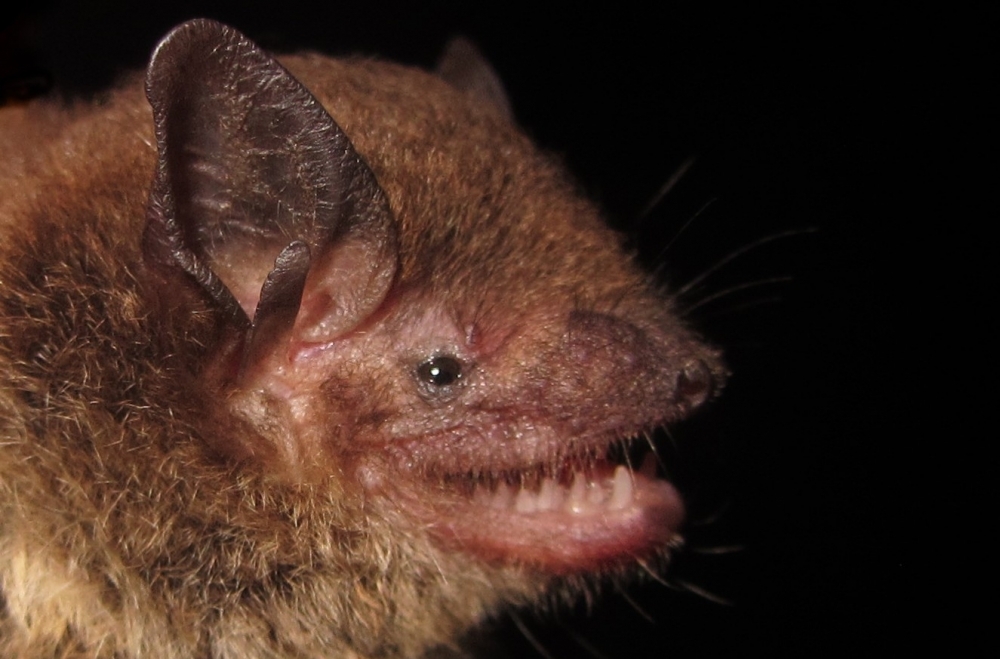


A Brazilian study that reconstructs the evolutionary history of flying mammals suggests expenditure of resources to gestate two young simultaneously results in a shorter lifespan (Argentine brown bat, Eptesicus furinalis; photo: Guilherme Siniciato Terra Garbino)
Published on 11/16/2021
By André Julião | Agência FAPESP – While rats can have half a dozen pups per litter and skunks a few dozen, most bats deliver one offspring per gestation. In Vespertilionidae, the only bat family capable of having twins, this trait is accompanied by lower longevity. A Brazilian study published in Biological Journal of the Linnean Society suggests that significant resource allocation to the gestation of twins reduces the lifespan of these tiny flying mammals.
Signed by researchers at the University of São Paulo (USP), the Federal Universities of Viçosa (UFV), Sergipe (UFS) and Paraíba (UFPB), all in Brazil, and the Chinese Academy of Sciences, the study reconstructs the evolutionary history of bats and shows how having twins correlates directly with a shorter lifespan and roosting in foliage. Bats that give birth to two offspring simultaneously live nine years less on average than bats that deliver one.
“We also show that group size doesn’t correlate with the capacity to have twins. This characteristic can occur in species that care for their young individually or in large groups of females. The benefits of cooperation apparently surpass the cost of possible competition within the group,” said Guilherme Siniciato Terra Garbino, first author of the study, which was conducted while he was a postdoctoral intern at USP’s Luiz de Queiroz College of Agriculture (ESALQ) with a scholarship from FAPESP.
A phylogenetic analysis – reconstructing the group’s evolutionary history based on its living members – showed that bats acquired the ability to have twins at least twice but lost it about 18 times. By the end of the process, only Vespertilionidae, which comprises some 490 species distributed around the world, retained this trait.
“It happened only twice in about 1,400 existing species, and so was very rare in the history of bats. And it happened precisely in this very species-rich, widely distributed family, which has had great evolutionary success. The family’s common ancestor was probably an animal that had twins, and that capacity was lost at least 18 times, so it’s a trait that emerged rarely and was lost frequently. The reason was probably its high cost in the lives of these animals,” said Garbino, currently a professor in UFV’s Department of Animal Biology.
Leafy nursery
The study also points to a correlation between roost type and litter size. Species that root in tree foliage are more likely to gestate two offspring at once than species that roost in caves or rock fissures. Foliage roosters include species that roost under leaves, in leaflets or leaf sheaths, under tree bark, and on branches. Roosting in cavities is less ephemeral and less exposed than roosting in foliage, causing less loss of offspring, the researchers argue. For species that roost in foliage, gestating twins may mitigate the higher mortality rate.
However, the study found that group size does not influence the prevalence of polytocy, the production of at least two offspring per gestation. The researchers began with the hypothesis that roosting in large groups was not the rule among polytocous bats because it would probably favor competition for food and other resources for offspring.
However, the statistical analyses did not point to significant differences in group size. The advantages of communal roosting, such as keeping warm, appear to outweigh the disadvantages.
“Bats are endothermic, like us, and raise their body temperature when they huddle together,” Garbino said. “That’s very important for thermoregulation of their young. During the growth stage, while they’re still breastfeeding, they should be warm if they’re to grow properly.”
Even though there are some 1,400 bat species in the world, the researchers found data for only 550. During a pandemic caused by a coronavirus that appears to have originated in bats, lack of knowledge about these animals should be an incentive to do more research on them.
“Perhaps if we divided the number of diseases caused by bats by the number of species now alive, the result wouldn’t be a lot of diseases they cause. What we need is to study them more and strengthen their conservation, so that it becomes increasingly rare for pathogens to jump from bats to other species,” he said.
The article “Evolution of litter size in bats and its influence on longevity and roosting ecology” by Guilherme Siniciato Terra Garbino, Anderson Feijó, Raone Beltrão-Mendes and Patrício Adriano Da Rocha is at: academic.oup.com/biolinnean/article/132/3/676/6090169.
Source: https://agencia.fapesp.br/37323